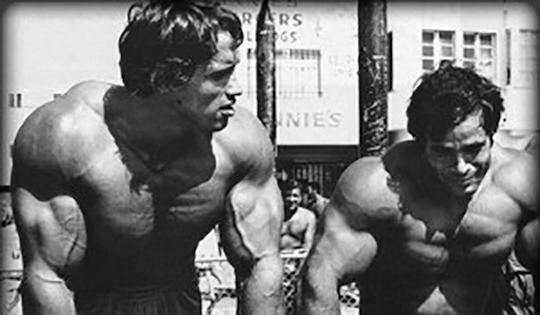With The Full Body Training Advantage Part 1, you learned the reasons why I prefer full-body routines over splits. In Part 2, I want to tell you how you can design your own full-body workout routines.
Where do you start with Full-Body Training?
At first you need to pick exercises. Like I said in the first part, you need to pick compound exercises like squats or deadlifts. Usually the more weight you use the more this exercise is beneficial. For example, Military Press and Bench Press are more beneficial than fly’s and triceps kickbacks. Squats and Deadlifts are more beneficial than leg extensions and leg curls. Pull-Ups and Bent-Over Rows are more beneficial than curls. You get the idea. But you may ask what about Military Presses vs Bench Presses? Or Squats vs Leg Presses?This is an issue for the whole post actually. But in two words, Military Presses are more beneficial than Bench Presses, and Squats will be more effective than Leg Presses. The issue here is that Military Presses and Squats are free-standing exercises. They involve much more muscles into action. They make greater impact on body composition. The most effective exercises on this planet are those where you standing on your feet. Pull-Ups, Dips and all the gymnastic exercises do count. Someone can disagree but it’s rough reality.
Don’t worry about implements. You can mix them as you wish. If you like sandbag training you can do it exclusively. If you prefer kettlebells and body weight over sandbags. No big deal. Work with those implements. Like barbells and dumbbells? No problem. Do what you like.
What’s next for Full-Body Training?
Mix and match. There are lots of opinions on how to structure a full-body routine but I like to keep it simple: Upper Body Push + Upper Body Pull + Lower Body Movement = Full-Body Workout. It’s the combination that brought me the best results. It is a combination that many fitness and strength experts preach, including Brooks Kubik and Chad Waterbury.
Here’s a sample Full-Body Training routine:
Full-Body Training Workout A:
A1) Kettlebell Double Military Press 5×5
A2) Pull-Ups 5×5
A3) Barbell Squats 5×5
Perform all sets in circuit fashion. Rest no more than 2 minutes between sets. Start with your seven rep max. Use the same weight for all sets. When you will be able to finish all sets and all reps add weight or cut the rest periods.
Full-Body Training Workout B:
A) Sandbag Floor Press 3×8
B) Kettlebell One-Arm Bent-Over Row 3×8 (each hand)
C) Barbell Deadlift 3×8
Perform all sets in straight fashion. Rest no more than 2 minutes between sets. Start with your ten rep max. Use the same weight for all sets. When you will be able to finish all sets and all reps add weight or cut the rest periods.
Full-Body Training Workout C:
A1) Dips 2×12
A2) Kettlebell Alternating Renegade Row 2×12
Perform all sets in alternating fashion. Rest no more than 2 minutes between sets. Start with your fourteen rep max. Use the same weight for all sets. When you will be able to finish all sets and all reps add weight or cut the rest periods. Finish all the sets and then move on to the next exercise.
B) Sandbag Zercher Squat 2×12
Rest no more than 2 minutes between sets. Start with your fourteen rep max. Use the same weight for all sets. When you will be able to finish all sets and all reps add weight or cut the rest periods.
Full-Body Training Workout Routine Schedule
Try to follow this routine on a 3-day-a-week schedule. For example, Monday-Wednesday-Friday of Tuesday-Thursday-Saturday. Pick any combination you will be able to follow. Just make sure that there’s at least one full day of rest between workouts. If it is too much try 2-day-a-week schedule. For example, Monday-Thursday or Tuesday-Friday. It will look like this:
Monday: Workout A
Thursday: Workout B
Monday: Workout C
Generally speaking you should get stronger almost every workout. Don’t worry about curls and core work. Your guns will grow like weed and with proper diet your abs will be ripped as hell (:
Here you go. Now you have a simple ready-to-go full-body routine that you can use to gain strength, build muscle and lose fat. But what about splits?
Full-Body Training Splits
I’d like to say some words here on splits actually. If for some reason you don’t like full-body routines or simply like splits so much that you won’t even try full-body routine it’s ok. But you need to understand that your body is like a machine. It always works as a whole unit. So when you will be designing your split let your logic be the guide. Sometimes people follow hilarious splits and don’t even analyze what they are doing. As a result they build tremendous muscle imbalances instead of harmonic body. You know, people tend to work what they like more instead of what needs to be worked. That’s why you see people benching and curling instead of squatting and deadlifting. So if you are fond of splits make them well-balanced. How to do it? The easiest way is to split upper body and lower body into two sessions. That’s how you will save balance and find time for your precious isolation. Bodypart splits are inefficient for natural athletes in my opinion.
Here’s a sample split routine:
Full-Body Training Workout A – Upper Body
A1) Barbell Bench Press 5×5
A2) Weighted Pull-Ups 5×5
Perform all sets in alternating fashion. Rest no more than 2 minutes between sets. Start with your seven rep max. Use the same weight for all sets. When you will be able to finish all sets and all reps add weight or cut the rest periods. Finish all the sets and then move on to the next exercises.
B1) Barbell Standing Curls 2×6
B2) Lying Triceps Extentions 2×6
Same directions as above except when you will be able to finish
all sets and all reps add reps until you hit 12 with this weight. Then add weight.
Full-Body Training Workout B – Lower Body
A) Front Squats 5×5
B) Deadlift 3×5
C) Calf Raises 3×10-12
Perform all sets in straight fashion. Rest no more than 2 minutes between sets. When you will be able to finish all sets and all reps add weight or cut the rest periods. Feel free to add some core work in the end but don’t get too carried away.
Perform workouts back-to-back. For example:
Monday: Workout A
Wednesday: Workout B
Friday: Workout A
Monday: Workout B
Wednesday: Workout A
Friday: Workout B
Repeat.
If it’s too easy for you then try this approach:
Monday/Thursday: Workout A
Tuesday/Friday: Workout B
I think it’s no-brainer that you should use perfect technique on every rep. Try one of these routines and e-mail me on how they worked for you to roughstrength@yahoo.com or into comments.
Stay tuned for more on rough training.
Play rough!

)





